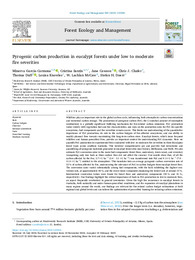Por favor, use este identificador para citar o enlazar este ítem:
https://hdl.handle.net/11000/36241Registro completo de metadatos
| Campo DC | Valor | Lengua/Idioma |
|---|---|---|
| dc.contributor.author | García-Carmona, Minerva | - |
| dc.contributor.author | Santín, Cristina | - |
| dc.contributor.author | Cawson, Jane | - |
| dc.contributor.author | Chafer, Chris J. | - |
| dc.contributor.author | Duff, Thomas | - |
| dc.contributor.author | Knowles, Louisa | - |
| dc.contributor.author | McCaw, W. Lachlan | - |
| dc.contributor.author | Doerr, Stefan H. | - |
| dc.contributor.other | Departamentos de la UMH::Agroquímica y Medio Ambiente | es_ES |
| dc.date.accessioned | 2025-03-31T10:00:43Z | - |
| dc.date.available | 2025-03-31T10:00:43Z | - |
| dc.date.created | 2025 | - |
| dc.identifier.citation | Forest Ecology and Management 585 (2025) 122590 | es_ES |
| dc.identifier.issn | 03781127 | - |
| dc.identifier.uri | https://hdl.handle.net/11000/36241 | - |
| dc.description.abstract | Wildfires play an important role in the global carbon cycle, influencing both atmospheric carbon concentrations and terrestrial carbon storage. The production of pyrogenic carbon (PyC; the C-enriched product of incomplete combustion) is a globally significant buffering mechanism for fire-related carbon emissions. PyC production varies widely with vegetation fuel and fire characteristics, and data on the production rates for PyC for specific ecosystems, fuel components and fire severities remain scarce. This limits our understanding of the quantitative importance of PyC production, its role in the carbon budgets of fire-affected ecosystems, and our ability to modify planned fires towards maximizing this long-term carbon store. Eucalypt forests, which incur frequent wildfires and human-prescribed fires, provide an important context for understanding PyC dynamics. Here we quantify PyC production in experimental fires conducted with low- to moderate fire severities in three Eucalyptus forest types across southern Australia. This involved comprehensive pre and post-fire fuel inventories and quantifying all pyrogenic materials generated in eucalypt forest sites near Sydney, Melbourne, and Perth. We also estimate PyC conversion rates in the main fuel components: forest floor, understory, down wood, and overstory (comprising only tree bark as these surface fires did not affect the crowns). Our results show that, of all the carbon affected by the fire, 2.7 t C ha− 1 (2.4 – 3.1 t C ha− 1 ) was transformed into PyC and 9.3 t C ha− 1 (7.9 – 11.0 t C ha− 1 ) emitted to the atmosphere. This translates into an average pyrogenic carbon conversion rate of 23 % of carbon affected by fire, underscoring the relevance of PyC in carbon budgets from eucalypt forest fires. The conversion rates varied substantially among fuel components, with the bark exhibiting the highest con- version rate, at approximately 40 %, and the down wood component displaying the lowest rate at around 15 %. Intermediate conversion values were found for forest floor and understory components (20 % and 31 %, respectively). Our findings highlight the critical importance of bark in PyC production in low to moderate fires, an aspect frequently overlooked in general inventories. Given the high fire recurrence in eucalypt forests in Australia, both naturally and under human-prescribed conditions, and the expansion of eucalypt plantations in many regions around the world, our findings are relevant for fire-related carbon budget estimations at both regional and global levels and can inform the optimization of prescribed burning for reducing carbon emissions. | es_ES |
| dc.format | application/pdf | es_ES |
| dc.format.extent | 13 | es_ES |
| dc.language.iso | eng | es_ES |
| dc.publisher | Elsevier | es_ES |
| dc.rights | info:eu-repo/semantics/openAccess | es_ES |
| dc.rights | Attribution-NonCommercial-NoDerivatives 4.0 Internacional | * |
| dc.rights.uri | http://creativecommons.org/licenses/by-nc-nd/4.0/ | * |
| dc.subject | Bark | es_ES |
| dc.subject | Carbon budgets | es_ES |
| dc.subject | Charcoal | es_ES |
| dc.subject | Eucalypt plantations | es_ES |
| dc.subject | Fuels | es_ES |
| dc.subject | Prescribed burning | es_ES |
| dc.subject | Southern Australia | es_ES |
| dc.subject.other | CDU::5 - Ciencias puras y naturales::54 - Química | es_ES |
| dc.title | Pyrogenic carbon production in eucalypt forests under low to moderate fire severities | es_ES |
| dc.type | info:eu-repo/semantics/article | es_ES |
| dc.relation.publisherversion | https://doi.org/10.1016/j.foreco.2025.122590 | es_ES |

Ver/Abrir:
GarciaCarmona2025_FOREST.pdf
9,79 MB
Adobe PDF
Compartir:
 La licencia se describe como: Atribución-NonComercial-NoDerivada 4.0 Internacional.
La licencia se describe como: Atribución-NonComercial-NoDerivada 4.0 Internacional.
.png)